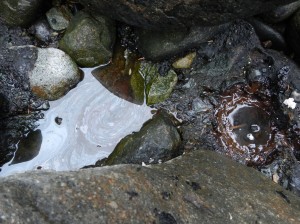Still-fresh remnants of Exxon Valdez oil protected by boulders

Oil trapped between rocks on a beach in the Gulf of Alaska. New research being presented at the Ocean Sciences Meeting finds that beaches on the Alaska Peninsula hundreds of kilometers from the site of the 1989 Exxon Valdez oil spill still harbor small hidden pockets of oil. Credit: Gail Irvine, USGS
The focus of the study is to learn how oil persists long after a spill. Researchers presenting the work caution that the amount of oil being studied is a trace of what was originally spilled and that results from these sites cannot be simply extrapolated to the entire spill area.
The rocky, high-energy coastlines in the Shelikof Strait, southwest of the spill, contain small remnants of the spill which appear to be protected by a stable boulder and cobble “armor,” says Gail Irvine of the U.S. Geological Survey’s Alaska Science Center. “To have oil there after 23 years is remarkable,” said Irvine. “We have these marked boulders whose movement we’ve been studying for more than 18 years. The oil itself has hardly weathered and is similar to 11-day-old oil.”
The oil was positively identified as that from the Exxon Valdez by chemists at the National Oceanic and Atmospheric Administration’s Auke Bay Laboratory and in Christopher Reddy’s lab at Woods Hole Oceanographic Institution, which specializes in investigating oil spills of all kinds – particularly those which are decades old.
“Very old oil spills can be found to still have oil,” said Reddy. “We were capable of fingerprinting that oil.”
The new findings from this study – about where oil can persist and which chemical compounds in the oil are more and less durable – offer some “silver linings” to the disastrous spill, said Reddy. The researchers are presenting the new research today at the 2014 Ocean Sciences Meeting co-sponsored by the Association for the Sciences of Limnology and Oceanography, The Oceanography Society and the American Geophysical Union.
“One lesson is that if you are responsible for cleaning up a spill, you want to be proactive about cleanup behind the boulders,” said Reddy. Another is that response efforts should try to prevent oil from stranding in these areas where oil may persist for years or decades.
“We are taking advantage of these samples as a natural laboratory,” he said.
Notes for Journalists:
The researchers on this study will present a poster about their work on Wednesday 26 February 2014 at the Ocean Sciences Meeting. The meeting is taking place from 23 – 28 February at the Hawaii Convention Center in Honolulu. For more information for members of the news media, please go to http://www.sgmeet.com/osm2014/media.asp.
Below is an abstract of the presentation. The presentation is part of Session 047: Natural and anthropogenic changes in Coastal Ecosystems and their impact on human welfare. Poster presentations for this session will take place Wednesday 26 February from 4 p.m. to 6 p.m. local Hawaii time in the Poster/Exhibit Hall located in Kamehameha Hall III.
Poster presentation
Session #:047
Date: 26 February 2014
Time: 4:00 p.m. to 6:00 p.m.
Location: Poster/Exhibit Hall
Authors:
Irvine, G. V., U.S. Geological Survey, Alaska Science Center, Anchorage, AK, USA;
Mann, D. H., University of Alaska, Fairbanks, AK, USA;
Carls, M., NOAA, Auke Bay Laboratories, Juneau, AK, USA;
Reddy, C., Woods Hole Oceanographic Institution, Woods Hole, MA, USA;
Nelson, R. K., Woods Hole Oceanographic Institution, Woods Hole, MA, USA.
Abstract:
Twenty-three years after the 1989 Exxon Valdez, spill, oil deposited as mousse persists on rocky shores of national parks in the Gulf of Alaska, distant from the spill origin. Oil persistence is highly dependent on the stability of the boulder armors, some of which have remained intact for 20+ years. Surface oiling has declined to very low levels while subsurface oiling continues relatively unchanged at 4 of the 6 sites. Deployment of passive samplers at 2 sites revealed that some oil constituents are moving into the water. At 4 sites, the oil is only slightly weathered. Comprehensive two-dimensional gas chromatographic (GC x GC) analyses have significantly increased the discrimination of oil compounds; especially pertinent is enhanced resolution of biomarkers, useful for the identification of oil source. Thin-layer chromatography-flame ionization detection analyses indicate no significant accumulation of recalcitrant oxygenated hydrocarbons at 4 of the sites, consistent with only minor oil weathering.
Contact information for the researchers:
Gail Irvine, +1 (907) 268-7606, gvirvine@gmail.com
Chris Reddy, +1 (858) 414-6787, creddy@whoi.edu
Mary Catherine Adams
+1 (202) 412-0889
mcadams@agu.org
Media Contact
More Information:
http://www.agu.orgAll latest news from the category: Earth Sciences
Earth Sciences (also referred to as Geosciences), which deals with basic issues surrounding our planet, plays a vital role in the area of energy and raw materials supply.
Earth Sciences comprises subjects such as geology, geography, geological informatics, paleontology, mineralogy, petrography, crystallography, geophysics, geodesy, glaciology, cartography, photogrammetry, meteorology and seismology, early-warning systems, earthquake research and polar research.
Newest articles

“Nanostitches” enable lighter and tougher composite materials
In research that may lead to next-generation airplanes and spacecraft, MIT engineers used carbon nanotubes to prevent cracking in multilayered composites. To save on fuel and reduce aircraft emissions, engineers…

Trash to treasure
Researchers turn metal waste into catalyst for hydrogen. Scientists have found a way to transform metal waste into a highly efficient catalyst to make hydrogen from water, a discovery that…

Real-time detection of infectious disease viruses
… by searching for molecular fingerprinting. A research team consisting of Professor Kyoung-Duck Park and Taeyoung Moon and Huitae Joo, PhD candidates, from the Department of Physics at Pohang University…




















